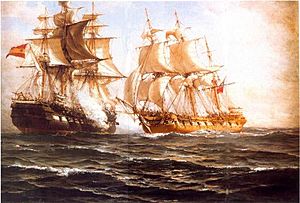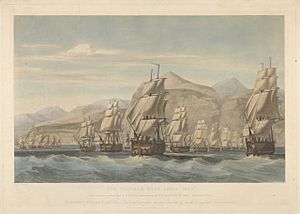Chilean ship Lautaro (1818) facts for kids

Lautaro (right) fought against Esmeralda (left) off Valparaíso in 1818
|
|
Quick facts for kids History |
|
|---|---|
| Name | Windham |
| Owner | Sir Robert Wigram, later Joseph Andrews |
| Operator | East India Company |
| Route | England-India |
| Builder | Perry, Wells & Green, Blackwall Shipyard |
| Yard number | 110 |
| Launched | 3 November 1800 |
| Fate | Sold to Chile 1818 |
| Name | Lautaro |
| Namesake | Mapuche military commander Lautaro |
| Cost | 180,000 pesos |
| Acquired | 5 April 1818 |
| Commissioned | April 1818 |
| Out of service | 27 September 1828 |
| Honours and awards |
Capture of Reina María Isabel, Perla and San Miguel |
| Fate | Sold as pontoon in Valparaíso, scrapped 1829 |
| General characteristics | |
| Type | East Indiaman |
| Tons burthen | 820, or 82347⁄94 or 878> (bm) |
| Length |
|
| Beam | 36 ft 1+1⁄4 in (11.0 m) |
| Depth of hold | 14 ft 9+1⁄2 in (4.5 m) |
| Propulsion | sail |
| Crew |
|
| Armament |
|
The ship Lautaro started its life as the British ship Windham. It was built in 1800 by Perry, Wells & Green at the Blackwall Shipyard for the East India Company (EIC). The Windham made seven trips for the EIC, sailing to places like India, Ceylon, and China.
During its time as a British ship, it was captured by the French twice, but the British also managed to get it back twice! In 1818, the Windham was bought by the Chilean Navy and renamed Lautaro. It then played an important role in the wars that helped Chile and Peru become independent. From 1824, it served as a training ship until it was sold in 1828.
Contents
The British Ship Windham
The Windham was a type of ship called an East Indiaman. These were large merchant ships built for the East India Company to carry valuable goods between England and countries in Asia. Because these voyages often happened during wartime, the Windham had a special permission called a letter of marque. This allowed its crew to capture enemy ships if they had the chance.
Early Voyages and Challenges
The Windham made its first trip to China in 1801. It sailed from Portsmouth, England, and reached places like Saint Helena and Whampoa (in China). It returned to England in 1802.
Its second voyage, starting in 1803, took it to Madras and Bengal in India. This was during the Napoleonic Wars, so sailing was risky. On its way back to England in 1804, the Windham was part of a large group of ships traveling together for safety. Sadly, one ship in the group, the Prince of Wales, sank in bad weather, and everyone on board was lost.
The Windham continued its voyages, sailing to India and China again in 1805-1806 and to Bengal and Benkulen in 1807-1808.

Captured and Recaptured: A Dramatic Voyage
The Windham's fifth voyage (1809-1811) was very eventful. It was captured by the French not once, but twice!
- First Capture:' On 18 November 1809, the French frigate Vénus captured the Windham and two other British ships. Six of the Windhams crew were killed, and 18 were wounded.
- First Recapture: Just over a month later, on 29 December, the British frigate HMS Magicienne recaptured the Windham. Its captain and crew rejoined the ship in February 1810.
But the adventure wasn't over!
- Second Capture: On 3 July 1810, the French frigate Bellone captured the Windham again near Johanna Island.
- Second Recapture: The British ship HMS Sirius recaptured the Windham at the Battle of Grand Port on 21 August 1810. The Windham was then sent to Île Bourbon (now Réunion).
After all these captures and recaptures, the Windham finally made it back to Britain in August 1811.

Later Voyages and Sale
The Windham made a sixth voyage between 1813 and 1815, carrying soldiers to New South Wales, Australia, and then sailing to Calcutta, India.
Its seventh and final voyage for the East India Company was from 1816 to 1817, sailing to China. Since the Napoleonic Wars were over, it no longer needed a letter of marque. After this trip, the East India Company sold the Windham to Joseph Andrews.
The Chilean Warship Lautaro
In 1818, the Chilean government bought the Windham for 180,000 pesos. It was refitted with 44 guns and renamed Lautaro, after a famous Mapuche military leader. The ship was given a crew of Chilean and foreign sailors.
Fighting for Freedom
A month after being bought, the Lautaro went to sea under the command of Captain George O'Brien, a former British Royal Navy officer.
- Lifting the Blockade: On 26–27 April 1818, the Lautaro fought against the Spanish frigate Esmeralda and the brigantine Pezuela near Valparaíso. Although Captain O'Brien and his boarding party were killed in the attack, the Lautaro succeeded in breaking the Spanish blockade of Valparaíso.
- Capturing Spanish Ships: Later that year, under Captain Charles Whiting Wooster, the Lautaro was part of a Chilean squadron that surprised a Spanish fleet at Talcahuano on 28 October. The Lautaro and another Chilean ship, San Martín, captured the Spanish frigate Reina María Isabel (which later became the Chilean ship O'Higgins), along with the Perla and the San Miguel.
Blockades and Expeditions
In 1819, under the command of Captain Martin Guise, the Lautaro took part in blockading the port of Callao in Peru. It also successfully attacked ships in the port of Pisco with another Chilean ship, Galverino. In 1820, the Lautaro was part of the Freedom Expedition of Perú, which led to the capture of the Spanish flagship Esmeralda at Callao.
From 1821, Captain Paul Delano commanded the Lautaro. The ship was involved in some difficult times, including when sailors on Chilean Navy ships were unhappy about not being paid. In 1823, the Lautaro sailed to blockade and attack the island of Chiloé, which was the last place where Spanish royalists still had control.
In late 1823 and early 1824, the Lautaro was part of an expedition to Peru that was not successful.
Training Ship and Final Days
In 1824, the Lautaro became the Chilean Navy's Naval academy (Academia Náutica) in Valparaíso, serving as a training ship for future sailors.
On 27 September 1828, the ship was ordered to be sold. However, no one bought it at the auction, so it was turned into a pontoon (a floating platform). The Lautaro was finally broken up in 1829.
Images for kids
-
The East Indiaman Windham sets sail from Cape Town
-
Capture of the Reina María Isabel in Talcahuano (1818)





